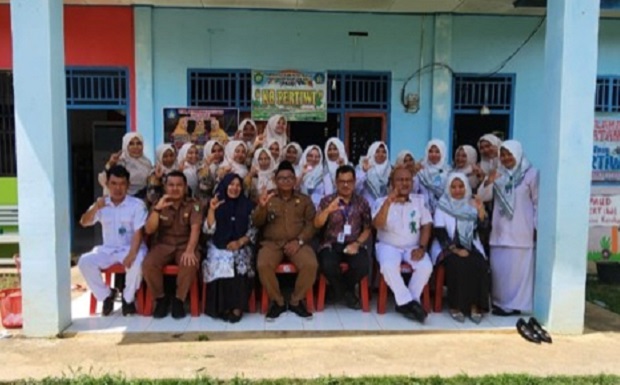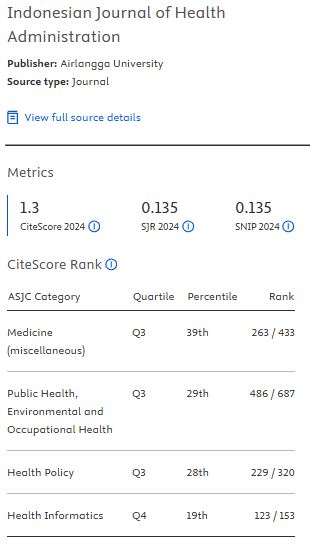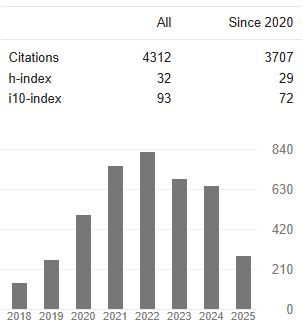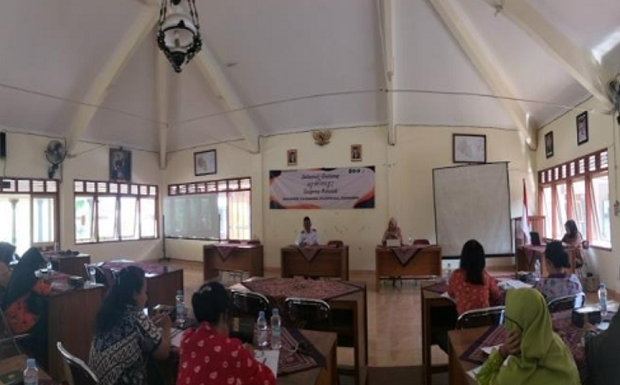IMPROVING PATIENT SAFETY CULTURE (PSC) IN PRIMARY HEALTH CENTERS IN JAMBI PROVINCE

Downloads
Background: Patient safety incidents continue to occur in primary health care services despite being 24% to 85% preventable. Promoting and assessing patient safety culture is the primary step to minimize and prevent adverse incidents.
Aims: This research examined the level of patient safety culture implementation in Primary Health Centers.
Methods: A quantitative descriptive research design was conducted involving 319 employees randomly selected from 11 Primary Health Centers in Jambi province. Data were collected using the Hospital Survey on Patient Safety Culture (HSOPSC) questionnaire and analyzed descriptively, with an average cut-off point of 75%.
Results: The implementation level of patient safety culture in the Primary Health Centers in Jambi Province was 71.5%. Furthermore, seven dimensions of patient safety culture were weakly implemented: staffing, communication openness, organizational learning for continuous improvement, supervisor/manager expectations and actions promoting patients, non-punitive response to error, general perception of patient safety, and frequency of error reporting.
Conclusion: Continuous examination should be conducted to ensure better changes in improving patient safety culture.
Keywords: Jambi Province, Patient safety culture, Primary health center
Al Lawati, M.H. et al. (2019) ‘Assessment of patient safety culture in primary health care in Muscat, Oman: a questionnaire -based survey’, BMC Family Practice, 20(1), p. 50. Available at: https://doi.org/10.1186/s12875-019-0937-4.
Alfadhalah, T. et al. (2022) ‘The Association Between Patient Safety Culture and Accreditation at Primary Care Centers in Kuwait: A Country-Wide Multi-Method Study’, Risk Management and Healthcare Policy, 15. Available at: https://doi.org/10.2147/RMHP.S383925.
Araújo, G.L. et al. (2022) ‘Patient safety culture in primary health care: Medical office survey on patient safety culture in a Brazilian family health strategy setting’, PLoS ONE, 17(7 July). Available at: https://doi.org/10.1371/journal.pone.0271158.
Arzahan, I.S.N., Ismail, Z. and Yasin, S.M. (2022) ‘Safety culture, safety climate, and safety performance in healthcare facilities: A systematic review’, Safety Science. Available at: https://doi.org/10.1016/j.ssci.2021.105624.
Astriyani, S., Suryoputro, A. and Budiyanti, R.T. (2021) ‘Pelaksanaan Keselamatan Pasien di Puskesmas X Ditinjau dari Tujuh Langkah Menuju Keselamatan Pasien’, MEDIA KESEHATAN MASYARAKAT INDONESIA, 20(3). Available at: https://doi.org/10.14710/mkmi.20.3.150-158.
Fassi, C.F. et al. (2024) ‘Assessment of patient safety culture in Moroccan primary health care: a multicentric study’, BMC Nursing, 23(1). Available at: https://doi.org/10.1186/s12912-024-01864-6.
Guspianto, Ibnu, I.N. and Solida, A. (2021) ‘Predictors of hospital patient safety culture outcomes in Jambi Province’, Enfermeria Clinica, 31. Available at: https://doi.org/10.1016/j.enfcli.2021.07.024.
Guspianto, Ibnu, I.N. and Wardiah, R. (2022) ‘Peningkatan Budaya Keselamatan Pasien Di RSUD Ahmad Ripin Kabupaten Muaro Jambi’, 5(1). Available at: https://doi.org/10.22437/medicaldedication.v5i1.18642.
Kavanagh, K.T. and Cormier, L.E. (2023) ‘Viewpoint: Patient safety in primary care - Patients are not just a beneficiary but a critical component in its achievement’, Medicine (United States). Available at: https://doi.org/10.1097/MD.0000000000035095.
Lai, A.Y. et al. (2020) ‘Patient safety in primary care: Conceptual meanings to the health care team and patients’, Journal of the American Board of Family Medicine, 33(5). Available at: https://doi.org/10.3122/JABFM.2020.05.200042.
Lawati, M.H.A. et al. (2019) ‘Assessment of patient safety culture in primary health care in Muscat, Oman: a questionnaire -based survey’, BMC Family Practice, 20(1). Available at: https://doi.org/10.1186/s12875-019-0937-4.
Lee, S.E. et al. (2019) ‘Safety Culture, Patient Safety, and Quality of Care Outcomes: A Literature Review’, Western Journal of Nursing Research. Available at: https://doi.org/10.1177/0193945917747416.
Lee, S.E. and Dahinten, V.S. (2021) ‘Using dominance analysis to identify the most important dimensions of safety culture for predicting patient safety’, International Journal of Environmental Research and Public Health, 18(15). Available at: https://doi.org/10.3390/ijerph18157746.
Lee, Y.C. et al. (2019) ‘A longitudinal study of identifying critical variables influencing patient safety culture from nurses’ viewpoints in Taiwan’, Journal of Testing and Evaluation, 47(5). Available at: https://doi.org/10.1520/JTE20180060.
Lousada, L.M. et al. (2020) ‘Patient safety culture in primary and home care services’, BMC Family Practice, 21(1). Available at: https://doi.org/10.1186/s12875-020-01263-1.
Mistri, I.U., Badge, A. and Shahu, S. (2023) ‘Enhancing Patient Safety Culture in Hospitals’, Cureus [Preprint]. Available at: https://doi.org/10.7759/cureus.51159.
Morris, R.L., Giles, S. and Campbell, S. (2023) ‘Involving patients and carers in patient safety in primary care: A qualitative study of a co-designed patient safety guide’, Health Expectations, 26(2). Available at: https://doi.org/10.1111/hex.13673.
Nora, C.R.D. and Beghetto, M.G. (2020) ‘Patient safety challenges in primary health care: a scoping review’, Revista Brasileira de Enfermagem. Available at: https://doi.org/10.1590/0034-7167-2019-0209.
Sousa, V.T. dos S. et al. (2023) ‘Professional burnout and patient safety culture in Primary Health Care’, Revista Brasileira de Enfermagem, 76(3). Available at: https://doi.org/10.1590/0034-7167-2022-0311.
Tambajong, M.G., Pramono, D. and Utarini, A. (2022) ‘Adaptasi Linguistik Kuesioner Hospital Survey on Patient Safety Culture ke Versi Indonesia’, The Journal of Hospital Accreditation, 04.
Tirzaningrum, A. et al. (2022) ‘Literature Review On Factors Influencing Reporting Of Patient Safety Incidents In Health Care Personnel’, Agromedicine, 9(2). Available at: https://juke.kedokteran.unila.ac.id/index.php/agro/article/view/3091.
Wanda, M.Y., Nursalam, N. and Wahyudi, A.S. (2020) ‘Analysis of Factors Affecting Reporting of Patient Safety Incident in Nurses’, Fundamental and Management Nursing Journal, 3(1). Available at: https://doi.org/10.20473/fmnj.v3i1.17284.
WHO (2023) ‘WHO | Patient safety’, WHO [Preprint]. Available at: https://www.who.int/news-room/fact-sheets/detail/patient-safety.
Copyright (c) 2025 Guspianto Guspianto, Nurlinawati Nurlinawati, Dessy Pramudiani

This work is licensed under a Creative Commons Attribution-ShareAlike 4.0 International License.
1. As an author you (or your employer or institution) may do the following:
- make copies (print or electronic) of the article for your own personal use, including for your own classroom teaching use;
- make copies and distribute such copies (including through e-mail) of the article to research colleagues, for the personal use by such colleagues (but not commercially or systematically, e.g. via an e-mail list or list server);
- present the article at a meeting or conference and to distribute copies of the article to the delegates attending such meeting;
- for your employer, if the article is a ‘work for hire', made within the scope of your employment, your employer may use all or part of the information in the article for other intra-company use (e.g. training);
- retain patent and trademark rights and rights to any process, procedure, or article of manufacture described in the article;
- include the article in full or in part in a thesis or dissertation (provided that this is not to be published commercially);
- use the article or any part thereof in a printed compilation of your works, such as collected writings or lecture notes (subsequent to publication of the article in the journal); and prepare other derivative works, to extend the article into book-length form, or to otherwise re-use portions or excerpts in other works, with full acknowledgement of its original publication in the journal;
- may reproduce or authorize others to reproduce the article, material extracted from the article, or derivative works for the author's personal use or for company use, provided that the source and the copyright notice are indicated.
All copies, print or electronic, or other use of the paper or article must include the appropriate bibliographic citation for the article's publication in the journal.
2. Requests from third parties
Although authors are permitted to re-use all or portions of the article in other works, this does not include granting third-party requests for reprinting, republishing, or other types of re-use.
3. Author Online Use
- Personal Servers. Authors and/or their employers shall have the right to post the accepted version of articles pre-print version of the article, or revised personal version of the final text of the article (to reflect changes made in the peer review and editing process) on their own personal servers or the servers of their institutions or employers without permission from JAKI;
- Classroom or Internal Training Use. An author is expressly permitted to post any portion of the accepted version of his/her own articles on the author's personal web site or the servers of the author's institution or company in connection with the author's teaching, training, or work responsibilities, provided that the appropriate copyright, credit, and reuse notices appear prominently with the posted material. Examples of permitted uses are lecture materials, course packs, e-reserves, conference presentations, or in-house training courses;
























